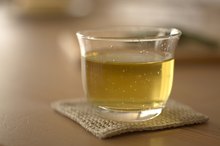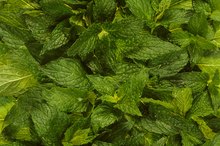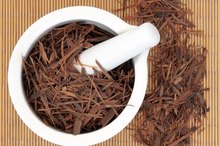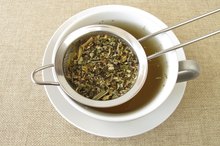What does fact checked mean?
At Healthfully, we strive to deliver objective content that is accurate and up-to-date. Our team periodically reviews articles in order to ensure content quality. The sources cited below consist of evidence from peer-reviewed journals, prominent medical organizations, academic associations, and government data.
- "British Medical Journal"; Effect of Fibre, Antispasmodics, and Peppermint Oil in the Treatment of Irritable Bowel Syndrome: Systematic Review and Meta-Analysis; Alexander C Ford, et. al; Nov 2008
- "British Medical Journal"; Effect of Fibre, Antispasmodics, and Peppermint Oil in the Treatment of Irritable Bowel Syndrome: Systematic Review and Meta-Analysis; Alexander C Ford, et. al; Nov 2008
The information contained on this site is for informational purposes only, and should not be used as a substitute for the advice of a professional health care provider. Please check with the appropriate physician regarding health questions and concerns. Although we strive to deliver accurate and up-to-date information, no guarantee to that effect is made.
The Nutrition in Peppermint Tea
Long used by many cultures for its medicinal properties, peppermint also makes a calming and mentally-clarifying tea. Though it is not high in macronutrients including fat, carbohydrates or protein, it contains vitamins, minerals and other components that can help with a wide variety of ailments. Peppermint tea is considered mild, but be sure to check with your doctor before consuming it regularly if you deal with a chronic illness.
Tips
Peppermint Tea has 2500 mg of Potassium K, per 100 gram serving according to the nutrition facts provided by the USDA Food Composition Database.
Identification
Peppermint tea comes from the dried leaves of the peppermint plant, a natural hybrid of spearmint and water mint, according to the Reader's Digest Association book "The Healing Power of Vitamins, Minerals, and Herbs." Harvesting of the leaves and stems of the plant occurs before the flowers bloom in summer 1. The major component of peppermint tea is peppermint oil, which contains all of the medicinal properties. Menthol, menthone and menthyl acetate provide peppermint tea's therapeutic effects.
- Peppermint tea comes from the dried leaves of the peppermint plant, a natural hybrid of spearmint and water mint, according to the Reader's Digest Association book "The Healing Power of Vitamins, Minerals, and Herbs."
Nutrition
Ballerina Tea & Weight Loss
Learn More
Peppermint tea contains about one calorie per serving, and does not have any fat, carbohydrates or protein. Still, it contains many nutrients, according to herbalist Kami McBride in her book "The Herbal Kitchen," including calcium, magnesium and potassium 2. Peppermint tea also has small amounts of vitamin A, vitamin C and folate. Peppermint tea is generally considered safe, but should not be used if you have a hiatal hernia or acute gallstones, adds McBride.
- Peppermint tea contains about one calorie per serving, and does not have any fat, carbohydrates or protein.
- Still, it contains many nutrients, according to herbalist Kami McBride in her book "The Herbal Kitchen," including calcium, magnesium and potassium 2.
Uses
Perhaps the most well-known use for peppermint tea is to help soothe the stomach and promote digestion. But in her book "20,000 Secrets of Tea," health writer Victoria Zak notes many other uses, including placing a bag of peppermint tea in a pot of boiling water and using it as an inhalant for chest congestion 3. She also recommends using a warm bag of tea on the skin where you feel a headache and drinking it to relieve stress and effectively stop nausea and seasickness. Peppermint tea can also be gargled to relieve toothaches.
- Perhaps the most well-known use for peppermint tea is to help soothe the stomach and promote digestion.
- But in her book "20,000 Secrets of Tea," health writer Victoria Zak notes many other uses, including placing a bag of peppermint tea in a pot of boiling water and using it as an inhalant for chest congestion 3.
Research
Essiac Tea Side Effects
Learn More
Studies have shown that peppermint oil, which is contained in peppermint tea, can be helpful for a variety of ailments. A systematic review of trials conducted in 2008 and published in the "British Medical Journal" found that peppermint oil was more effective than a placebo in the treatment of irritable bowel syndrome 4. A 2006 review in "Phytotherapy Research" of the potential health benefits of peppermint tea found that in vitro, peppermint is antimicrobial and antiviral, holds strong antioxidant and antitumor actions and some antiallergenic potential, but human studies of peppermint tea are lacking.
Related Articles
References
- "The Healing Power of Vitamins, Minerals, and Herbs"; Reader's Digest Association; 1999
- "The Herbal Kitchen"; Kami McBride; 2010
- "20,000 Secrets of Tea"; Victoria Zak; 1999
- "British Medical Journal"; Effect of Fibre, Antispasmodics, and Peppermint Oil in the Treatment of Irritable Bowel Syndrome: Systematic Review and Meta-Analysis; Alexander C Ford, et. al; Nov 2008
- National Center for Complementary and Integrative Health. Peppermint Oil. Updated September 2016.
- Khanna R, Macdonald JK, Levesque BG. Peppermint Oil for the Treatment of Irritable Bowel Syndrome: A Systematic Review and Meta-Analysis. J Clin Gastroenterol. 2014;48(6):505-512. doi:10.1097/MCG.0b013e3182a88357
- Shavakhi A, Ardestani SK, Taki M, Goli M, Keshteli AH. Premedication With Peppermint Oil Capsules in Colonoscopy: A Double Blind Placebo-Controlled Randomized Trial Study. Acta Gastroenterol Belg. 2012;75(3):349-353.
- May B, Köhler S, Schneider B. Efficacy and tolerability of a fixed combination of peppermint oil and caraway oil in patients suffering from functional dyspepsia. Aliment Pharmacol Ther. 2000;14(12):1671-1677. doi:10.1046/j.1365-2036.2000.00873.x
- Borhani Haghighi A, Motazedian S, Rezaii R, et al. Cutaneous application of menthol 10% solution as an abortive treatment of migraine without aura: a randomised, double-blind, placebo-controlled, crossed-over study. Int J Clin Pract. 2010;64(4):451-456. doi:10.1111/j.1742-1241.2009.02215.x
- Göbel H, Fresenius J, Heinze A, Dworschak M, Soyka D. [Effectiveness of Oleum Menthae Piperitae and Paracetamol in Therapy of Headache of the Tension Type]. Nervenarzt. 1996;67(8):672-681. doi:10.1007/s001150050040
- Thosar N, Basak S, Bahadure RN, Rajurkar M. Antimicrobial efficacy of five essential oils against oral pathogens: An in vitro study. Eur J Dent. 2013;7(Suppl 1):S71-77. doi:10.4103/1305-7456.119078
- Meamarbashi A. Instant effects of peppermint essential oil on the physiological parameters and exercise performance. Avicenna J Phytomed. 2014;4(1):72-78.
- Masoumi SZ, Asl HR, Poorolajal J, Panah MH, Oliaei SR. Evaluation of mint efficacy regarding dysmenorrhea in comparison with mefenamic acid: A double blinded randomized crossover study. Iran J Nurs Midwifery Res. 2016;21(4):363-367. doi:10.4103/1735-9066.185574
- Mount Sinai. Peppermint oil overdose.
Writer Bio
Christine Garvin is a certified nutrition educator and holds a Master of Arts in holistic health education. She is co-editor of Brave New Traveler and founder/editor of Living Holistically... with a sense of humor. When she is not out traveling the world, she is busy writing, doing yoga and performing hip-hop and bhangra.









